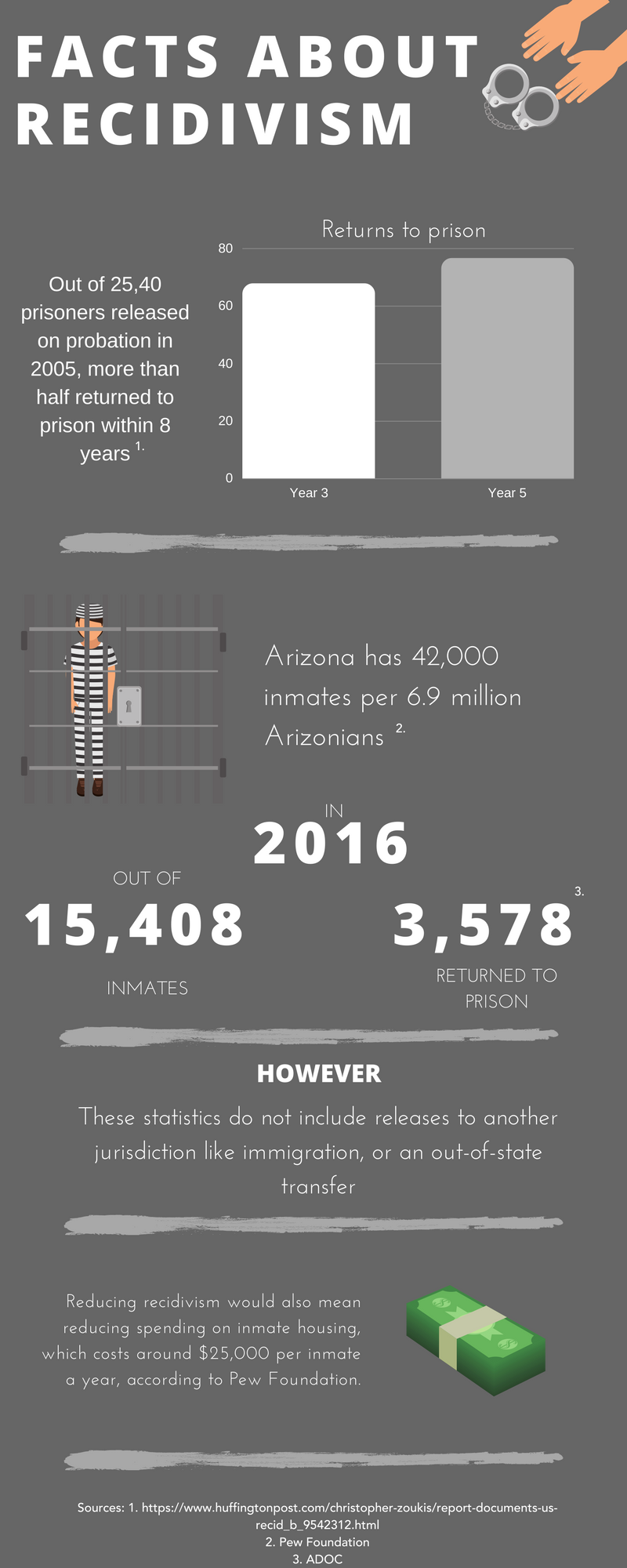The Arizona Department of Corrections Reentry Facility in North Phoenix could move to South Phoenix, according to authorities.
Azcentral reported State plans for a 335-bed employment center and a 265-bed reentry center on the Maricopa County Durango Jail campus in southwest Phoenix. The plans are still tentative due to push back from neighbors. The new center would help inmates learn job skills and search for post-release employment.
If they do build the new center in South Phoenix, the re-entry center currently being operated out of the north Phoenix facility at 29th Avenue and Pinnacle Peak Road will be transferred, according to azcentral.
The reentry center in North Phoenix assists individuals recently released from prison and provides programs, life skills classes, services and temporary housing, so recently released inmates don’t end up on the streets.
Even though reentry centers usually get negative feedback from its neighbors, they help reduce recidivism. Recidivism is defined as a tendency of a convicted criminal to reoffend.
Recently released inmates have a 60 percent chance of returning back to prison in the state of Arizona, according to authorities. In some areas of Arizona, which lack affordable housing and job opportunities, recidivism is especially high. The Arizona Republic reported South Phoenix neighborhoods in ZIP codes 85041 and 85042 have some of the highest recidivism rates in Phoenix and in the country.
According to the Arizona Department of Corrections, Arizona has 16 state prisons, six of which are run by private companies. Arizona has 42,000 inmates per 6.9 million Arizonians, while Massachusetts, that has a similar population, only has 11,000 inmate population, according to Pew Foundation.
Sue Ellen Allen, a founder and executive director of Reinventing Reentry, said the recidivism rate is about 60 percent, but measuring recidivism is hard because some inmates go back to prison not just for a committing a crime but on a technicality.
“I heard the director of the Federal Bureau of Prisons say, ‘Trying to measure recidivism is like trying to nail Jell-O to the wall,’ Allen said. “And I couldn’t believe it, but he was right.”
Allen said there are many things the department of corrections count as a part of recidivism. Many felons go back on a technicality like being late to a half-way house or dating another former inmate which still counts toward recidivism.
There are many efforts to reduce recidivism and educate communities about it. Reinventing Reentry is a non-profit organization that assists newly released inmates to find housing and gain employment therefore reducing recidivism rates, building securer communities, and directing taxpayers’ money towards something else other than inmate housing.
Many prisons have programs to teach inmates basic skills and even earn college credits, but sometimes they can’t even make it to classes because their correction officer does not give them a pass.
Julie Brown, a former program manager at the ADOC, was running one of these programs. The Department of Justice granted $750,000 to teach inmates skills to help them get an employment upon release.
Inmates earned 12 credit hours in AutoCAD classes, learned resume writing, interview skills to get higher level jobs, however, the employers still would not hire them. Brown said one of the IT companies would not employ former inmates because people working at the office could be afraid of them.
Isadora Dahlen, an educator and coach for women, teaches creative class for women in prison. She only gets hour and a half a week and tries hard to get women to tell their stories. Many have experienced significant trauma during childhood like rape or molestation, they attracted wrong people, and made bad decisions.
Dahlen said 85 percent of her students are in for drugs or alcohol use, but the employers still would not employ them after release.
“I am disheartened and hopeful at the same time,” Dahlen said. “We are working really hard to do this, but it is really like the rest of the world doesn’t care about it.”
Both Dahlen and Brown agreed that educating the community is one of the first steps to reduce recidivism. Fear of the unknown is what makes people turn away from former inmates, therefore increasing their chances of going back to prison where they feel safe and know what to expect, according to Dahlen.
One of the recent steps in the efforts to lower recidivism and help former inmates get hired, was a decision of The Board of Supervisors of Maricopa County to remove questions about previous convictions from most job applications, unless required by specific departments. The convictions would still show in the background checks, however, only after a person already qualified for a job, giving former felons more chances of getting hired.







